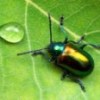[The following is a guest post by Rob Mitchell]
Rob here, back again with your answer to this week's mystery... not that you need it! And here I thought I was being tricky. Six points to FormicidaeFantasy for hitting the order, family, and genus, and another four to Gordon Snelling for making quick work of the specific epithet.

This beetle is a female Neoclytus tenuiscriptus, an uncommon little denizen of the American southwest (or the Mexican northwest, depending on where you're standing). According to Hovore's '83 monograph, the larvae bore in Baccharis, and specifically, can be found in mulefat.
Many of the clytine longhorned beetles, such as Neoclytus and Xylotrechus, break the cerambycid stereotype and can throw the public and an unwitting entomologist for a loop. The short antennae, prominent pronotum, and lanky hind legs have led to this and related beetles (such as Neoclytus acuminatus, below) being mistaken for grasshoppers!


I think if you really want to give people a hard time on species ID, you need to go for some of the little guys who live in the leaf litter and don't have obvious markings. Or nymphs/larvae of species that are normally only seen as adults. Of course, those often don't make for very striking photographs, so that could be a problem.
Grasshopper?! Where the heck do you think you are, Rob? Have you ever read this blog before? Are you used to teaching kindergarten? This is the big leagues, my friend. Next time post a cropped picture of half the leg of a mite on this species (or something). I'm sure you're a wonderful guy; my rants serve to entertain others as much as to educate their victims. No hard feelings? :-)
Warren
I chose this insect because it's a beautiful and rare species that I wanted to get in the spotlight. I figured most would be able to hit the genus, but I admit I did hope that the species would be more difficult! My apologies. Just for you, Warren, if I ever fill in again I'll post a single tarsomere. ;)
And just when I was gettin' cozy ... thinking that there was a Monday Night Mystery that I might actually be able to answer, given a quick enough trigger finger.
Alex is gonna hit us hard next Monday!